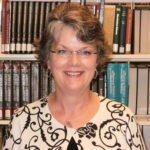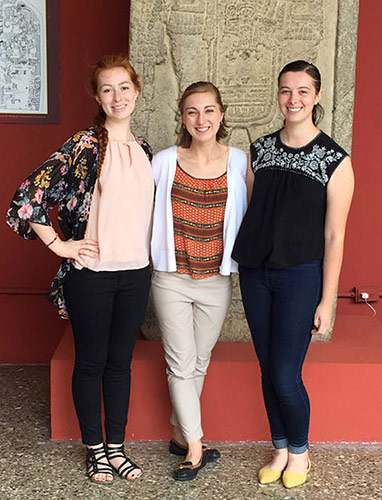
Major Discovery of Royal Tomb Has Strong Wooster Ties

WOOSTER, Ohio – A major discovery of a royal tomb, provisionally dated to 300-350 AD, at the ancient Maya city of Waka’ in northern Guatemala has direct ties to The College of Wooster. Locating the tomb, which is the oldest to be discovered at the site, according to members of the Proyecto Argueológico Waka’ and the Ministry of Culture and Sports of Guatemala, was credited to the U.S.-Guatemalan El Perú-Waka’ Archaeological Project, of which Wooster assistant professor of archaeology Olivia Navarro-Farr serves as a co-principal investigator (PI).
A group of Guatemalan archaeologists – Griselda Pérez, Juan Carlos Pérez, and Damaris Menéndez – supervised tunnel excavations inside the Palace Acropolis and ultimately the discovery, officially termed as “Burial 80,” now the earliest known royal tomb in the northwestern Petén region of Guatemala. Previous research has revealed other royal tombs in the area, including Navarro-Farr’s and Pérez Robles’ discovery in 2012 of K’abel’s tomb, a seventh-century Maya queen.
Though not in the field during the time of the discovery, Navarro-Farr and her team of Wooster students were not surprised. Navarro-Farr’s research, granted through the Alphawood Foundation, provided substantial financial support for the investigations, which were integral to the research design laid out in her proposal. Navarro-Farr is examining royal women as agents of statecraft in the Maya area and her previous work at the site as well as current investigations at the palace directly inform on these ideas.
Navarro-Farr was following the research from Wooster thanks to consistent updates provided by Juan Carlos Pérez, the project’s Guatemalan co-director. “The systematic investigations carried out by the team, led by Griselda, were not only meticulously executed, but now provide the most comprehensive understanding of the ‘Early Classic Palace’ construction sequences. The tomb itself is also incredibly important for our understanding of the foundation of the Waka’ dynasty,” stated Navarro-Farr.
Sarah Van Oss ’16 had helped record data at one of the Palace Acropolis courtyard excavations in 2014 and therefore knew this sector of the site. She noted that “starting excavations in the palace … (the team) hypothesized (such) a discovery could result from investigations there at some future time … but I had to go back to school before excavations even reached a floor.”
A researcher at the site since 2003 and now serving as one of the project’s co-PIs, Navarro-Farr provides archaeology majors research opportunities that are rarely available at the undergraduate level. “What’s most exciting for me was coming to Wooster as a student who wanted to study archaeology and … being able to work on this project that is so huge and finding incredible things every year,” said Hannah Bauer ’19, who is currently studying abroad in Mérida, México.
When the discovery was made this summer, Bauer, Van Oss, and another Wooster student, Hannah Paredes ’19, were all working at the project’s laboratory facility in Guatemala City, analyzing the ceramics and other material from Navarro-Farr’s excavations. Many of the vessels unearthed are household items, such as serving dishes and drinking cups, all made out of earthen wares, which makes for “a fascinating comparison as to the difference in how royalty lived compared to the common people,” according to Bauer. Paredes was quite taken by sherds of pots “that helped fill in gaps of what kind of world (they) lived in … and showed us artistic styles and motifs that were popular at the time.”
Working on excavations alongside professionals, which has also included fieldwork in Belize for Bauer, Paredes, and Van Oss, and in the lab, provides Wooster students a strong foundation that sets them apart in their budding archaeology careers. Van Oss is currently applying to graduate programs and feels she’s ready to take on any challenge, saying “I feel like I can do a lot with what I learned from Wooster … my experiences aren’t like anyone else at my age level.” And, Bauer stated “It really is that experiential learning that Wooster is all about … I certainly wouldn’t have had these opportunities available had I gone to a different university.”
With Navarro-Farr’s prominent position at the site, Wooster students will continue to take part in this unique hands-on research experience, as investigations are ongoing at El Perú-Waka’, and continue to generate Independent Study scholarship – Paredes plans on studying hieroglyphic inscriptions on one cylinder vessel pertaining to the K’abel tomb for her I.S.
Image: Wooster students Hannah Bauer ‘18, Sarah Van Oss ‘16, and Hannah Paredes ’18, pictured here at the National Museum of Archaeology and Ethnology in Guatemala, were performing research at the project’s lab facility when the 1,700-year-old royal tomb was discovered this summer.
Posted in Alumni, News on October 13, 2017.
Related Posts
Related Areas of Study
Archaeology
Fieldwork and research are a big part of the study of prehistoric and historical archaeology
Major Minor

